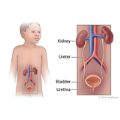Vesicoureteral Reflux (VUR)
Condition Basics
What is vesicoureteral reflux (VUR)?
Vesicoureteral reflux (VUR) is the backward flow of urine from the bladder into the kidneys. Normally, urine flows from the kidneys through the ureters to the bladder. The muscles of the bladder and ureters, along with the pressure of urine in the bladder, prevent urine from flowing backward through the ureters.
VUR allows bacteria, which may be present in the urine in the bladder, to reach the kidneys. This can lead to kidney infection, scarring, and damage.
What causes it?
There are two types of vesicoureteral reflux (VUR):
- Primary VUR is caused by a problem with the development of the valve at the end of the tube that carries urine from the kidneys to the bladder (ureter).
- Secondary VUR is also caused by a problem with the same valve. Something inside the bladder prevents the bladder from emptying by blocking the opening. This causes increased pressure in the bladder that keeps the valve from closing properly.
What are the symptoms?
Vesicoureteral reflux (VUR) doesn't cause any symptoms or pain. But it can result in kidney damage if a child who has VUR gets a urinary tract infection.
A urinary tract infection (UTI) can be a symptom of VUR. Symptoms of a UTI may include fever, pain or burning with urination, frequent urination, and the feeling that the bladder does not empty completely. Fever may be the only symptom of a UTI in a small child. So a urinary tract infection should be suspected in any child who has a high fever without an obvious cause.
How is it diagnosed?
Vesicoureteral reflux (VUR) is usually diagnosed with a test called a voiding cystourethrogram (VCUG).
VUR may be suspected before a child is born from the results of a prenatal ultrasound. Or VUR may be suspected in a young child who's had several urinary tract infections (UTIs).
Your doctor will ask about the history of your child's symptoms and do a physical exam.
The following tests may be recommended:
- A urine culture. This checks for a UTI.
- Ultrasound of the kidneys. This test uses sound waves to find out the size and shape of the kidneys. It can't detect reflux.
- Voiding cystourethrogram. This test can detect VUR and help find out if it's mild or severe. X-ray pictures are taken of the urinary tract.
VUR can be passed down from parent to child (inherited). If one of your children has VUR, you may want to ask your doctor if your other children need to be checked.
How is vesicoureteral reflux (VUR) treated?
Many children do not need treatment for vesicoureteral reflux (VUR). The ureters grow as a child gets older. Mild cases of VUR usually go away completely by the time a child is 5 years old.
With VUR, urinary tract infections (UTIs) are more likely. Antibiotics are often prescribed to prevent or treat UTIs and help reduce the chance of scarring that can lead to kidney damage. Your child may need to take continuous antibiotic treatment. Or your doctor may give you the option of carefully watching your child for signs of another UTI and only using antibiotics when your child gets a new infection.
Surgery may be needed to repair more severe cases of VUR.
Credits
Current as of: November 15, 2023
Author: Healthwise Staff
Clinical Review Board
All Healthwise education is reviewed by a team that includes physicians, nurses, advanced practitioners, registered dieticians, and other healthcare professionals.
Current as of: November 15, 2023
Author: Healthwise Staff
Clinical Review Board
All Healthwise education is reviewed by a team that includes physicians, nurses, advanced practitioners, registered dieticians, and other healthcare professionals.


